《Self-Introduction》 & 《History of my Hobby》
| NAME | Akira WATANABE |
| BIRTH | Born in Kawasaki (Kanagawa-Pref.) Japan in 1950 |
| OCCUPATION | Retired at the end of 2011. I had worked for several automotive part suppliers for a total of 38 years during 1973 and 2011. |
| HOME PLACEs (History of my moving) |
1950-1956: Kawasaki, Kanagawa-Pref. JAPAN 1956-1973: Meguro, Tokyo, JAPAN 1973-1977: Omiya, Saitama-Pref. JAPAN 1977-1990: Konosu, Saitama-Pref. JAPAN 1990-1994: Torrance, California, USA 1994-1996: Konosu, Saitama-Pref. JAPAN 1996-2009: Antioch, Tennessee, USA (near Nashville) 2009-2010: Aguascalientes, MEXICO 2010-2011: Antioch, Tennessee, USA (near Nashville) 2012-Current: Konosu, Saitama-Pref. JAPAN |
HISTORY OF MY HOBBY
1, SCHOOL DAYS
There were some background reasons why I became so crazy about aviation. I still remember that my mother took me to her parents' (my grand parents') house in Shizuoka twice or three times a year when I was a boy of elementary school. My grand parents had preserved a lot of their aviation books/magazines which were published during the second world war. Those books/magazines had a lot of photos and drawings of Japanese/British/US/German military aircraft operated during the second world war, and I was so keen on all those photos and drawings preserved in my grand parents' house in Shizuoka. Then I started visitting hobby(model) shops to buy wooden model kits of battle ships and war planes. As you may know, both TAMIYA and HASEGAWA are still headquarterd in Shizuoka, and they used to sell various wooden models when I was a elementary school boy. So, there were many model shops in Shizuoka.
Another influence came from my class teacher in charge of my elementary school. He used to be a Navy pilot flying Zero fighter during the second world war. He talked to us a lot of his pilot experiences in the class room. I still remember what he said....."Carrier landing was a real tough experience expecially under high waves because Japanese aircraft carriers were so small and it waved like a tiny leaf on the ocean." I well know now that the Japanese aircraft carriers were much much smaller than the USS.Nimits.!! When I went on to the Middle (Junior High) School, various foreign plastic models kits such as Monogram/Revell/Airfix /Hawk/Lindbergh became available in Tokyo, but they were a little too expensive for a middle school boy. So I had to empty my pocket money to get one. I still remember that I was extremely happy when I returned home with a Monogram kit in my small hands. During the Middle School days, I concentrated on building war planes of the second world war. I was especially keen on Monogram's 1/48 scale kits of the US Navy aircraft such as Hellcat/Avenger/Helldiver/ Wildcat/Dauntless because they had various moveable parts such as landing gears, wing, canopy and bomb bay.

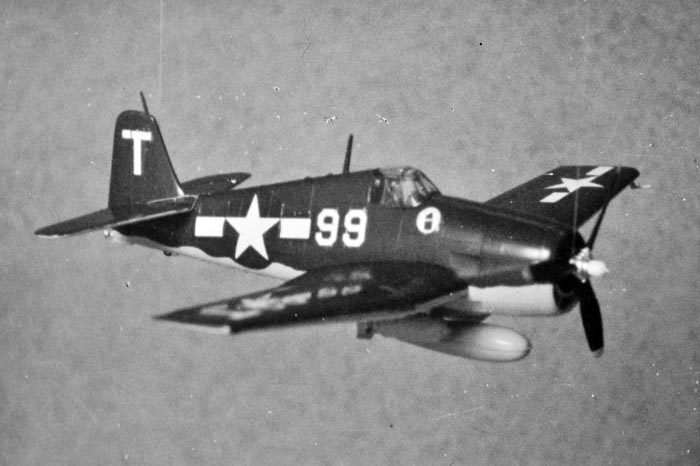
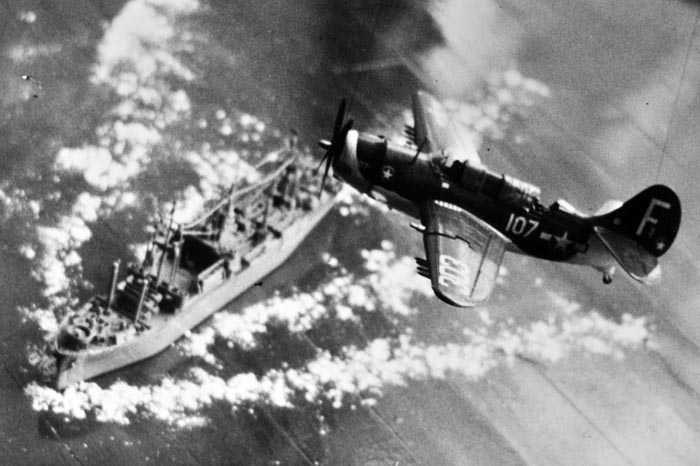
(Top Left) I, at right, was displaying my wooden model of the battleship YAMATO with my cousin, at left, when I was a boy
of about ten. (Top right) The happiest moment of my Middle School days.!! Myself, at most left, returned home from the
hobby shop with my cousins with Monogram kits in our hands. Naturally, my pocket became empty.!! (Bottom Left & Right)
Monogram's Hellcat, at left, and Helldiver which I built during my Middle School days.
2, MY FIRST CAMERA
I bought my first camera, Canon FX, when I was a hight school student, and I started taking photos of aircraft. Tokyo-Haneda airport was fairly close to my home in Tokyo, so I started with airliner photograpy with black & white films. I bought also a developing tank and a photo-enlarger and I learned how to develop films and how to enlarge photos.

I took the above two photos at Tokyo Haneda Airport during the late 1960's. Haneda airport used to be a very good airport for photographers and I was able to easily take good taxing shots from the observation deck all around the terminal building. (Left) Convair CV880 "JA8021 SAKURA" of Japan Air Lines. (Right) YS-11 "JA8656 AKASHI"of JDA/Japan Domestic Airways.
I started buying Japanese aviation magazines Koku-Fan and Aireview every month, and my interest shifted toward more and more on military side of aviation, becuase a lot of photos of US military aircraft operated in Vietnam appeared on every issue of the Japanese aviation magazines at that time. During the 1960's, US airbases near Tokyo, Yokota AB and NAS Atsugi, were very very busy to support US operations in South-East Asia. After I entered University in Tokyo in 1968, I started taking photos at Yokota and Atsugi with black & white films(mostly Tri-X or Plus-X). At the beginning, I hesitated to get close to the fences of the airfields simply because I did not know the security conditions around the airbases, and I wondered if I could be arrested during my photography. So I took landing/take-off shots appx. 1-2 km away from the end of the runway at the beginning. After a few months, I realized that some photographers took photos right next to the fences and I found some good (and "safe" too) shooting spots around the airfields.

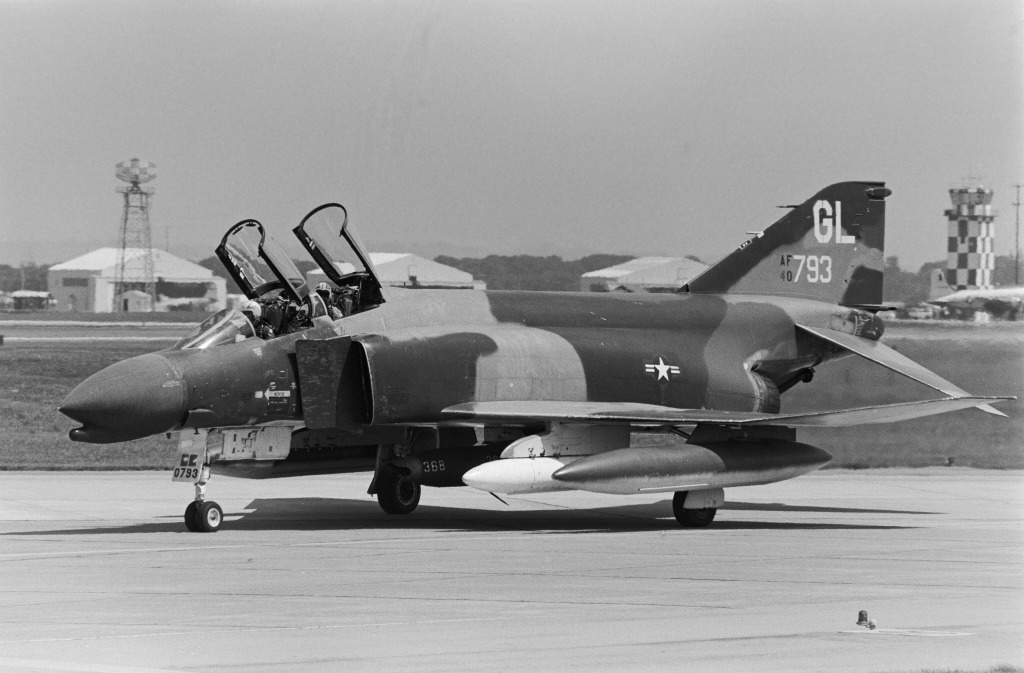

I took the above four photos in 1970. (Top Left) EKA-3B of VAQ-130/Det.3 USS.Oriskany on final at NAS.Atsugi. (Top Right) RB-57F of 56th WRS on its final to Yokota AB. (Bottom Left) F-4C of 36TFS "GL" taxing to the runway at Yokota. (Bottom Right) C-124C of N.C.ANG on final at Yokota.
3, MY FIRST TRIP ABROAD During my University days, I became interested in visitting foreign countries, but at that time in Japan, a trip abroad was limitted only for rich people, and a poor student like me could not afford to buy expensive tickets of international flight. No Expedia, no cheap tickets at all in 1970. However, I did find an inexpensive (but very long) travel to Europe via Siberia. I traveled to Europe twice via Siberia/Moscow (Ship, Train and Aeroflot) in 1970 and in 1971. I did not have any information at all at that time how to photograph military aircraft in Europe, so I had to concentrate mainly on airliners at civil airports. At Heathrow/London and at Schiphol/Amsterdam I did find a group of spotters gathered in a cafeteria and they were spotting aircraft and exchanging information to each other. I did find some photographers among them and I started exchanging b&w negatives and color slides with them after I returned to Japan. The only opportunity I had to photograph military aircraft in Europe at that time was at Soesterberg, Holland. One of the Dutch photographers I met at Schiphol gave me guidance how to get to the good shooting spot at Soesterberg. The shooting spot was very close to the taxi way and I did find several local photographers at that time. Unfortunately, it was not busy and I was able to photograph only several a/c including Danish F-104s.
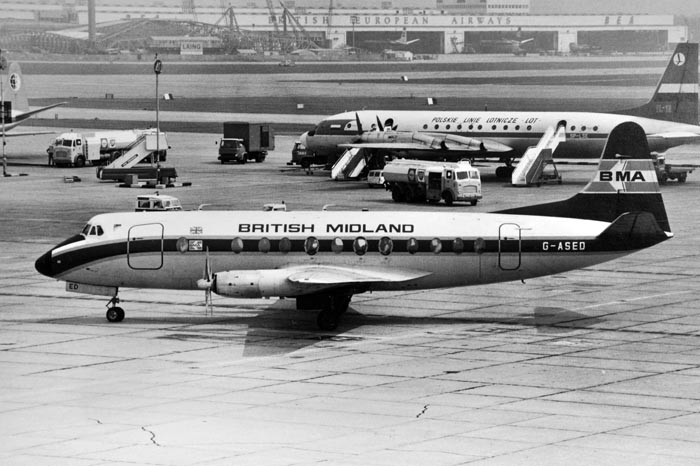
(Above Left) Caravelle of Jugoslovenski Aerotransport "YU-AHG" at Vienna airport in August 1970. (Above Right) Viscount of British Midland "G-ASED" taken at Heathrow in July 1970.
Even though I was not able to photograph a lot of military aircraft in Europe, I enjoyed my stay in Europe so much, and I was able to start exchanging b&w negatives and Kodachrome slides with some Dutch/British photographers. I had other unforgettable experiences in Russia on my way from Japan to western Europe. I was able to fly on the Aeroflot Tu-114 from Khabarovsk(Siberia) to Moscow, and it surely was a VERY interesting flight. I should be the only passenger on the plane who enjoyed so much on this unique noisy plane. I felt like a crew member of the Tu-95 Bear. Another good memory in Siberia was....I did come across a few Tu-16 Badgers flying low over my train on their final approach to an airbase in Siberia covered with heavy snow. 4, COLLECTION OF KODACHROME SLIDES Three F-4C squadrons of 347TFW based at Yokota moved to Kadena, Okinawa in March 1971 and Yokota AB became a slow transport base after that. So, I sifted my photo targets more toward Japanese (JSDF) aircraft after 1971. I graduated in 1973 and I joined a compay near Tokyo which manufuctured automotive parts for Nissan. During the 1970's, it was fairly easy to obtain photo permission from the JASDF/JMSDF airbases and I was able to take standard-lens shots of each and every aircraft on the flight line. I did so, mainly because I needed a lot of original color slides to swap with foreign correspondents. I learned from my correspondents that they most wanted sharp Kodachrome 25 slides, taken by standard lens, of static aircraft parked on the flight line free from people and the serial number had to be shown clearly. I tried my best to take such shots and many of my correspondents liked the quality of my slides. The number of my correspondents had been increased a little by little and finally I was exchanging color slides with more than fifty photographers in Europe, US, Canada, Australia, New Zealand and South Africa.
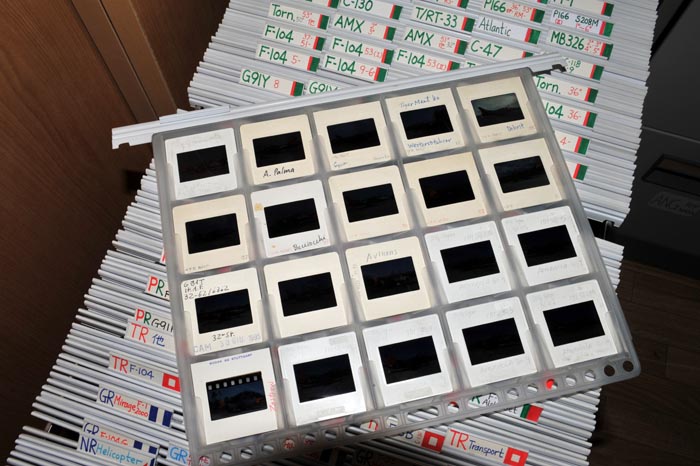
The above two photos show my slide cabinet at my home. I classified/sorted thousants of my slides by country, aircraft type and
squadron, and each folder can carry 20 slides per sheet as shown above.

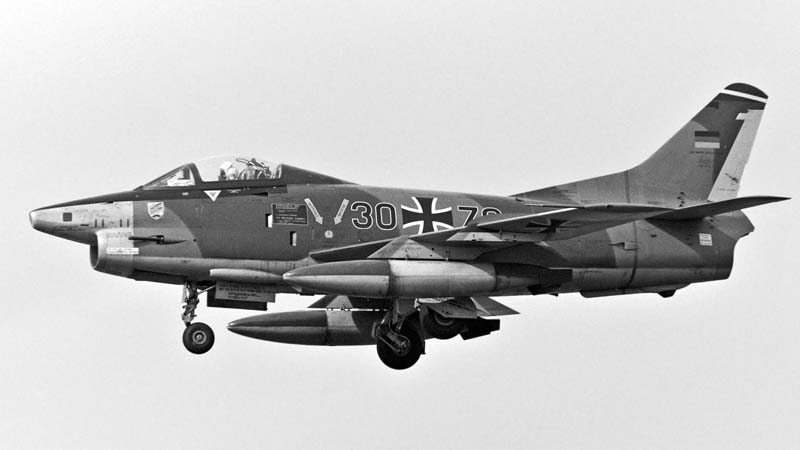



(Top Left) Royal Navy's Canberra T.22 of FRADU on final at RNAS Yeovilton in 1974. (Top Right)Luftwaffe G-91R of WS-50 on final at Furstenfeldbruck in 1974. (Bottom Left) KC-97L of Arizona ANG taken at SkyHarbor airport in Phoenix in 1975. (Bottom Center) Myself and a pilot of 84th FIS in front of his F-106A at Castle AFB in 1975. (Bottom Right) TA-4J of VT-24, Commander Training Wing Three on the transit ramp of Moffett Field in 1975.
Some of my correspondents came over to Japan (mostly from Europe) to photograph and spot Japanese aircraft during the 70's and the 80's and I supported them during their stay in Japan. It was so good to me too because they took me to US military airfields in Japan, NAS.Atsugi and MCAS.Iwakuni and I was able to take photos on the flight line together with them. For Japanese citizens without press background, it was very difficult to obtain photo permission from the US bases in Japan, so it was my rare opportunity to be able to photograph on the US bases in Japan.

(Above Left) In 1976 I was able to take photos on the flight line of VF-151(USS.Midway) together with my friends from England. One of my friends is seen on the photo in crouching down to change films. (Above Right) A group photo of British photographers and myself taken in front of the C-117D stationed at MCAS Iwakuni in 1979.
5, PUBLISH MY BOOK
I realized that a lot of foreign aviation enthusiasts were so interested in the post war Japanese military aviation. However there were NO English-written books at all about the post war Japanese military aviation(JSDF). So I decided to publish an English-written book about the JSDF for foreign enthusiasts. I plan to upload the scanned images of my book on this web page in the future.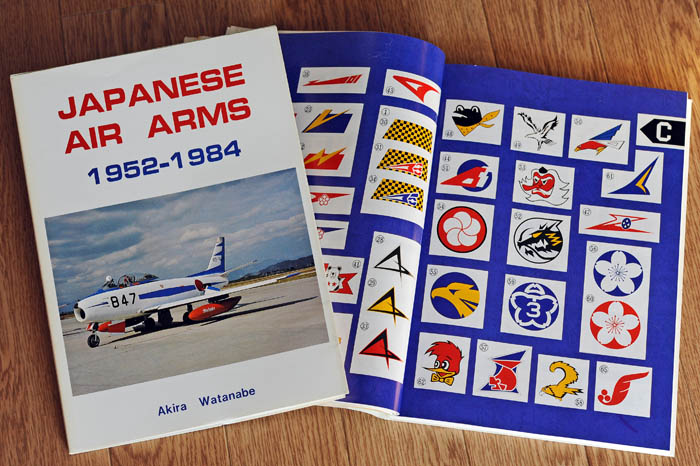

The above two photos shows my book I mentioned above, which was published in 1984 at my own expense. Emphasis was put on describing each unit with details of its markings and a brief history, serial numbers of the aircraft operated since 1952.
6, 20 YEARS OF THE USA ASSIGNMENT
At the beginning of 1990, I was assigned to the Los Angeles office of my company and I moved to Torrance, CA. It was a very good location for military aviation enthusiasts, because there were so many military airfields in southern California at that time. There was a photo tour at George AFB every month and most of the bases had an airshow every year. Public Affairs Ofices were so friendly to aviation enthusiasts and I was able to take a lot of standard lens shots on the flight line. Unfortunately, most of my correspondents were so disappointed at my move to California because I was not able to photograph JSDF a/c during my stay in US. Apart from the military airfields, I was so interested in Mojave airport and various air attack bases for fier fighting operation near Los Angeles such as Hemet and Fox Field. I frequently visited those civil airports to photograph military aircraft with the civil registrations. I did find several ex-JMSDF S2F-1s in the boneyard at Hemet air attack base. Another interesting civil airport I sometimes visited was Deer Valley airport near Phoenix, where I was able to photograph F-8K/L, TA-7C, TA/ERA-3B, CT-133 and C-123K of the Thunderbird Aviation.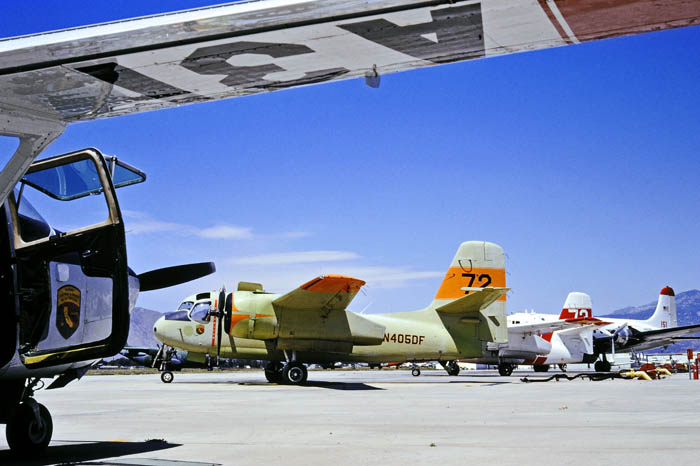
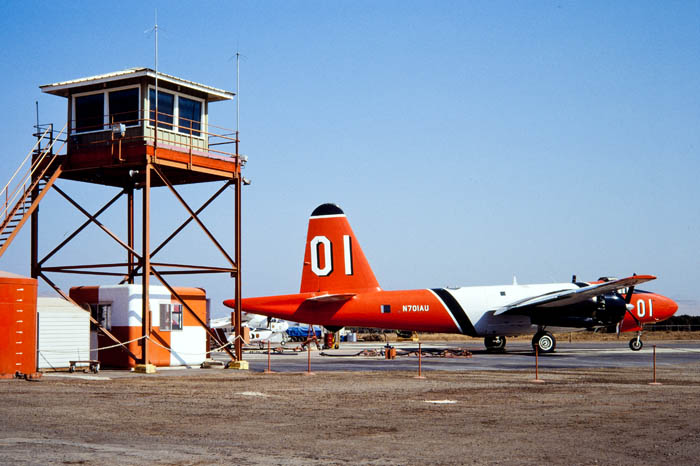
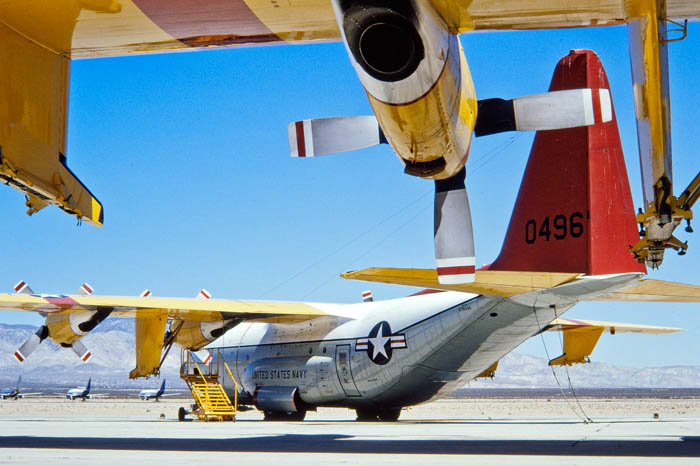

(Top Left) Peace time of the Hemet air attack base with, from the foreground, O-2A, TS-2A and C-54E. (Top Right) A P2V-7 based at Porterville air attack base in CA. (Bottom Left) DC-130As of the US.Navy operated by, I believed, the Flight Systems based at Mojave. (Bottom Right) F-100F of the Flight Systems based at Mojave. The above four photos were taken during 1990-1993.
In June 1994, my assignment at the Los Angeles Office was over and I returned to Japan. Only two years after that, I had my second assignment to the US in June 1996. This time, I moved to the company's Tennessee office located near Nashville. Speaking from the view point of a military aviation photographer, middle Tennessee was not so good place as southern California where I used to live. To make matters worse, most of the aircraft displayed at airshows were painted overall grey with low-visibility markings. The negative situation described above really discouraged my enthusiasm of taking Kodachrome shots of active military aircraft. This change of my mind came so suddenly and I fed up with grey overall F-15s, F-16s and F-18s at the end of the 1990's. At the same time, it had been getting more and more difficult(unpopular) to purchase Kodachrome 25(KM/PKM) films in the market. So, I decided to stop it. The last Kodachrome slide I made was at NAS Meridian airshow in May 1998.(Please see the photos below)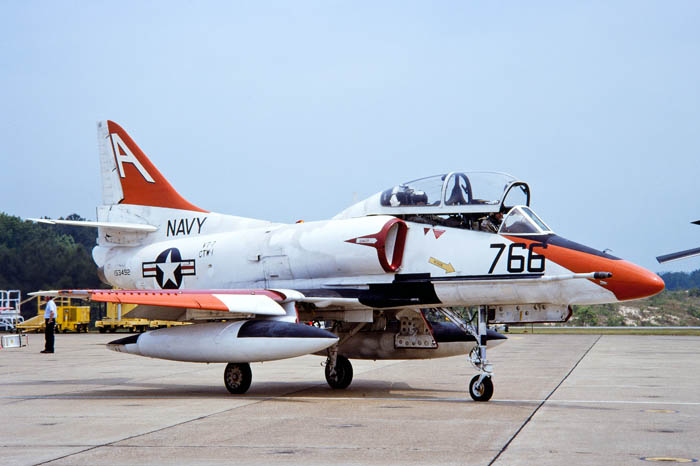

The above two photos were taken at NAS Meridian, MS on 24MAY98. It was the last day of my enthusiastic 26 years of Kodachrome photography. (Above Left) TA-4J of VT-7 taxied out from the ramp for a demonstration flight. (Above Right) TA-4Js and T-2Cs parked in a cramped area for the airshow.
7, SWITCH TO MODEL BUILDING
As I mentioned before, I used to build wooden/plastic models when I was young. However, when I started my serious photograpy in 1969-1970, I stopped model building. In 2000, I re-started my model building after I tired of all low-visibility aircraft in active service. I'm interested in all types of military aircraft operated during the 60's, 70's and the 80's. I joined the IPMS/USA and I attended the IPMS/USA National Convention for the first time in 2009. My entry at that time was a Tamiya's F-14A in 1/32 scale, which was awarded the first place within the category. My second visit to the Nation Convention was a 2011 event in Omaha, NE. My entry in 2011 was a 1/48 CH-113 Labrador converted from the Academy's CH-46, which was also awarded the first place in the category.(Please see the following photos.)

(Above Left) 2009 National Convention in Clumbus, OH. The F-14A on the most foreground with blue camouflage is my entry. (Above Right) 2011 National Convention in Omaha, NE. The yellow helicopter on the most foreground right is my entry.
15 years of my assignment was over at the end of 2011, and I returned to Japan finally. I retired at the same time and I'm now enjoying my retirement days. Naturally, I'm still so keen on building plastic models and I've just completed my recent project of Roden's 1/48 T-28B Trojan. I plan to re-visit the National Convention with the Trojan. My life-long goal is to complete a total of 60 models in the 21st century. The most recent 1/48 Trojan is my 20th model, which means I will have to complete additional 40 models before I die(Ha-Ha!!). It should be a great pleasure during the rest of my life. My "near future" projects will be (1) a Hobby Craft DHC-3 Otter in the CAF markings, (2) a Heller's 1/72 C-121 with the USN's "Project Magnet"-"Paisano Dos" markings, (3) a Hasegawa's 1/32 F-104G with Belgium markings, and (4) a Tamiya's 1/32 F-4C with the tail code "XT" on the Vietnam camouflage. I plan to upload the photos of my future projects on this web page in future.

(Above Left) A hangar of my squadron at my home in Japan. They all were built during my long stay in Tennessee. (Above Right) The trophies and plaques which were awarded from the IPMS/USA events, both local and national.
8, WALK AROUND PHOTOGRAPHY
After I re-stared my model building, I became so keen on walk-around photography at various aviation museums and airshow sites. Some of the walk-around photos are uploaded on this web page under the index of "Walk Around". Many of them were taken at various museums listed on the (please click) "TABLE".

(Above Left) USS.Midway museum in San Diego, California. (Above Right) A privately owned aviation museum in the middle of grape vineyard in Savigny-les-Beaune, France.
There are many books and web-pages which display various walk-around photos of aircraft. However I realized that many of them did not cover clear details on upper surfaces of the wings and fuselages. Reference photos of the panel/rivet line details on the upper surfaces are essential to make your models so accurate and realistic. So, I decided to photograph them by myself. I did try various ideas/measures to photograph the upper side of the wing and fuselage. The following photos explain how I photograph the upper surface details.


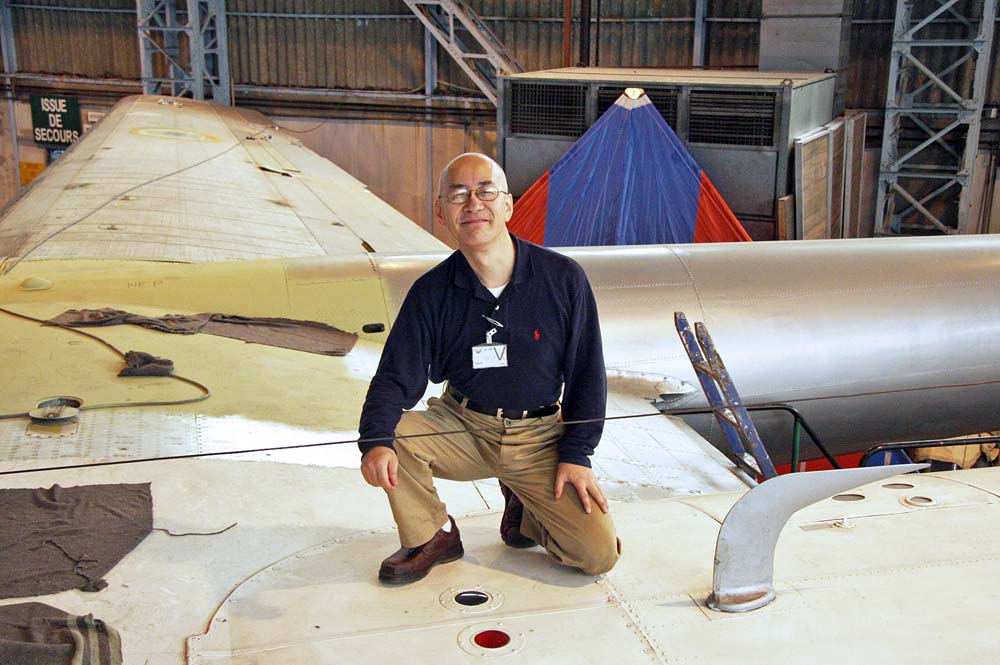
(Top Left) I use a retractable unipod (camera stick?), and I attach a camera on top of the unipod by using a camera platform as shown on the
photo.
(Top Right) This photo shows a Luftwaffe Tronade displayed at Pansacola airshow in 2011. Naturally, I had a prior
permission from the German crew to take this kind of photo. Please notice the shadow on the wing. I raised my camera with an
unipod as high as possible and press the shutter button on the remote control device on hand. If I need to raise my camera
much higher, I use my stepladder, and I stand on top of it and raise the camera in the same manner.
(Bottom Left) A friend of mine took this photo at National Museum of Naval Aviation in Pensacola.
This is the way how I take pictures of upper surfaces of the wing and fuselage.
(Bottom Right) Naturally, the easiest way to photograph the upper side is to obtain permission to get on the wing/fuselage
of the aircraft. This photo was taken on the roof of Nord 2501 Noratlas preserved at an Air Force Museum in Bordeaux, France
in 2008. The Noratlas' wing is too high to photograph its upper surfaces by using a unipod as explained above.
9, DIGITAL PHOTOGRAPHY
After I gave up Kodachrome photography in 1998, I had to switch to digital cameras. As I explained before, I became concentrating on model building after Kodachrome days, and I was no longer so interested in taking photos of active military aircraft in service EXCEPT for the walk-around photos. But I still take some (NOT so many as before) photos of active aircraft when I visit airshows with my digital camera. I no longer visit airbases on weekdays at all. The following digital photos were taken during the airshows.


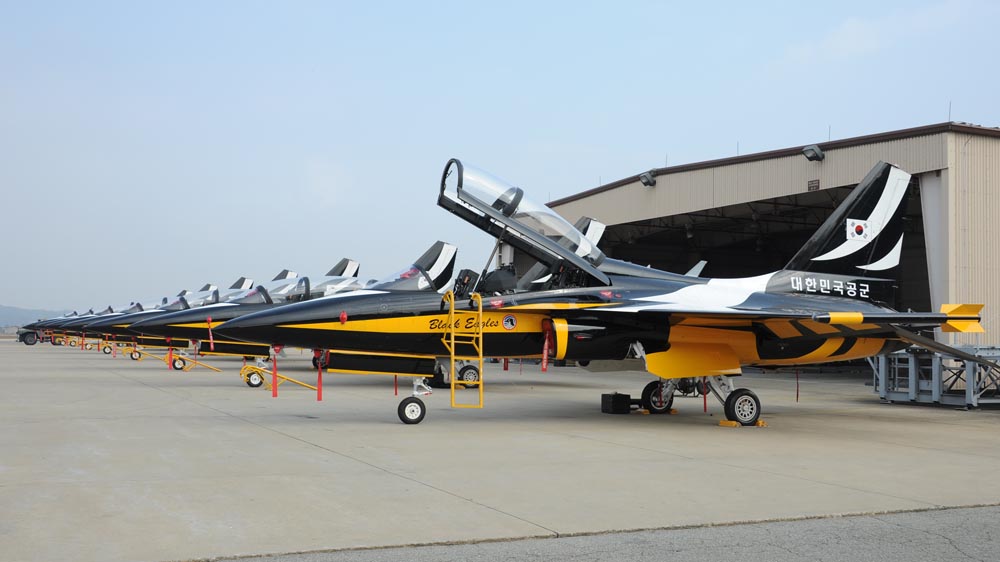
(Top Left) Polish Su-22M4 taxing at Florence, Belgium in July 2008. (Top Right) Slovak MiG-29 on final at Zeltweg, Austria in July 2011. (Bottom Left) A-4L of Draken International displayed at Nellis airshow in November 2012. (Bottom Right) Korean KA-50 of the Black Eagles displayed at Osan airshow in South Korea in October 2012.
Other activities besides the model building and aviation photography
The following video clips (youtube) show my other activities besides the above mentioned model building and photograpy.1, My first solo flight on a glider
This shows my first solo flight on a Schleicher ASK-21 at Eagleville, Tennessee on 15NOV98.2, Touch & Go practice on a Diamond Katana
This shows my touch and go practice on a Diamond Katana at Smyrna airport, TN on the runway #32. My first solo on a Diamond Katana was on 10DEC11.3, Practice of landing on my radio control plane
This shows my practice of landing and taking off on my radio control plane. My skill was still so poor that I made some accidents on landing. You can laugh at my poor control(Ha-Ha!!).| Top of this page | The "Introduction" page |